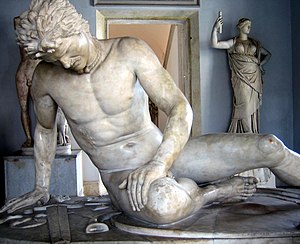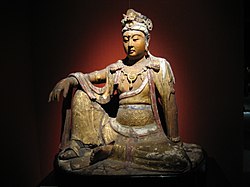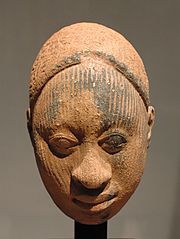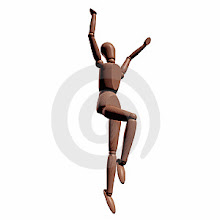Sculpture
From Wikipedia, the free encyclopedia


Sculpture is three-dimensional artwork created by shaping or combining hard and/or plastic material, sound, and/or text and or light, commonly stone (either rock or marble), metal, glass, or wood. Some sculptures are created directly by finding or carving; others are assembled, built together and fired, welded, molded, or cast. Sculptures are often painted [1]. A person who creates sculptures is called a sculptor.
Because sculpture involves the use of materials that can be moulded or modulated, it is considered one of the plastic arts. The majority of public art is sculpture. Many sculptures together in a garden setting may be referred to as a sculpture garden.
| |
Types of sculpture
Some common forms of sculpture are:
- Free-standing sculpture, sculpture that is surrounded on all sides, except the base, by space. It is also known as sculpture "in the round", and is meant to be viewed from any angle.
- Sound sculpture
- Light sculpture
- Jewelery
- Relief - the sculpture is still attached to a background; types are bas-relief, alto-relievo, and sunken-relief
- Site-specific art
- Kinetic sculpture - involves aspects of physical motion
- Statue - representationalist sculpture depicting a specific entity, usually a person, event, animal or object
- Bust - representation of a person from the chest up
- Equestrian statue - typically showing a significant person on horseback
- Stacked art - a form of sculpture formed by assembling objects and 'stacking' them
Materials of sculpture through history
Sculptors have generally sought to produce works of art that are as permanent as possible, working in durable and frequently expensive materials such as bronze and stone: marble, limestone, porphyry, and granite. More rarely, precious materials such as gold, silver, jade, and ivory were used for chryselephantine works. More common and less expensive materials were used for sculpture for wider consumption, including glass, hardwoods (such as oak, box/boxwood, and lime/linden); terracotta and other ceramics, and cast metals such as pewter and zinc (spelter).
Sculptures are often painted, but commonly lose their paint to time, or restorers. Many different painting techniques have been used in making sculpture, including tempera, [oil painting], gilding, house paint, aerosol, enamel and sandblasting[2][3][4].
Many sculptors seek new ways and materials to make art. Jim Gary used stained glass and automobile parts, tools, machine parts, and hardware. One of Pablo Picasso's most famous sculptures included bicycle parts. Alexander Calder and other modernists made spectacular use of painted steel. Since the 1960s, acrylics and other plastics have been used as well. Andy Goldsworthy makes his unusually ephemeral sculptures from almost entirely natural materials in natural settings. Some sculpture, such as ice sculpture, sand sculpture, and gas sculpture, is deliberately short-lived.
Sculptors often build small preliminary works called maquettes of ephemeral materials such as plaster of Paris, wax, clay, or plasticine, as Alfred Gilbert did for 'Eros' at Piccadilly Circus, London. In Retroarchaeology, these materials are generally the end product.
Sculptors sometimes use found objects.
Asian

Many different forms of sculpture were used in Asia, with many pieces being religious art based around Hinduism and Buddhism (Buddhist art). A great deal of Cambodian Hindu sculpture is preserved at Angkor, however organized looting has had a heavy impact on many sites around the country. In Thailand, sculpture was almost exclusively of Buddha images. Many Thai sculptures or temples are gilded, and on occasion enriched with inlays. See also Thai art
India
The first known sculptures are from the Indus Valley civilization (3300–1700 BC), found in sites at Mohenjo-daro and Harappa in modern-day Pakistan. These are among the earliest known instances of sculpture in the world. Later, as Hinduism, Buddhism, and Jainism developed further, India produced bronzes and stone carvings of great intricacy, such as the famous temple carvings which adorn various Hindu, Jain and Buddhist shrines. Some of these, such as the cave temples of Ellora and Ajanta, are examples of Indian rock-cut architecture, perhaps the largest and most ambitious sculptural schemes in the world.
During the 2nd to 1st century BC in northern India, in what is now southern Afghanistan and northern Pakistan, sculptures became more anatomically realistic, often representing episodes of the life and teachings of Gautama Buddha. Although India had a long sculptural tradition and a mastery of rich iconography, the Buddha was never represented in human form before this time, but only through symbols such as the stupa. This alteration in style may have occurred because Gandharan Buddhist sculpture in ancient Afghanistan acquired Greek and Persian influence. Artistically, the Gandharan school of sculpture is characterized by wavy hair, drapery covering both shoulders, shoes and sandals, and acanthus leaf decorations, among other things.
The pink sandstone sculptures of Mathura evolved during the Gupta Empire period (4th-6th century AD) to reach a very high fineness of execution and delicacy in the modeling. Gupta period art would later influence Chinese styles during the Sui dynasty, and the artistic styles across the rest of east Asia. Newer sculptures in Afghanistan, in stucco, schist or clay, display very strong blending of Indian post-Gupta mannerism and Classical influence. The celebrated bronzes of the Chola dynasty (c. 850-1250) from south India are of particular note; the iconic figure of Nataraja being the classic example. The traditions of Indian sculpture continue into the 20th and 21st centuries with for instance, the granite carving of Mahabalipuram derived from the Pallava dynasty. Contemporary Indian sculpture is typically polymorphous but includes celebrated figures such as Dhruva Mistry.
China
Artifacts from China date back as early as 10,000 BC and skilled Chinese artisans had been active very early in history, but the bulk of what is displayed as sculpture comes from a few select historical periods. The first period of interest has been the Western Zhou Dynasty (1050-771 BC), from which come a variety of intricate cast bronze vessels. The next period of interest was the Han Dynasty (206 BC-220 AD), beginning with the spectacular Terracotta Army assembled for the tomb of Qin Shi Huang, the first emperor of the important but short-lived Qin Dynasty that preceded the Han. Tombs excavated from the Han period have revealed many figures found to be vigorous, direct, and appealing 2000 years later.
The first Buddhist sculpture is found dating from the Three Kingdoms period (3rd century), while the sculpture of the Longmen Grottoes near Luoyang, Henan Province (Northern Wei, 5th and 6th century) has been widely recognized for its special elegant qualities.
The period now considered to be China's golden age is the Tang Dynasty, coinciding with what in Europe is sometimes called the Dark Ages). Decorative figures like those shown below became very popular in 20th century Euro-American culture, and were made available in bulk, as warlords in the Chinese civil wars exported them to raise cash. Considered especially desirable, and even profound, was the Buddhist sculpture, often monumental, begun in the Sui Dynasty, inspired by the Indian art of the Gupta period, and many are considered treasures of world art.
Following the Tang, Western interest in Chinese artifacts drops off dramatically, except for what might be considered as ornamental furnishings, and especially objects in jade. Pottery from many periods has been collected, and again the Tang period stands out apart for its free, easy feeling. Chinese sculpture has no nudes --other perhaps than figures made for medical training or practice -- and very little portraiture compared with the European tradition. One place where sculptural portraiture was pursued, however, was in the monasteries.
Almost nothing, other than jewelry, jade, or pottery is collected by art museums after the Ming Dynasty ended in the late 17th century -- and absolutely nothing has yet been recognized as sculpture from the tumultuous 20th century, although there was a school of Soviet-influenced social realist sculpture in the early decades of the Communist regime, and as the century turned, Chinese craftsmen began to dominate commercial sculpture genres (the collector plates, figurines, toys, etc) and avant garde Chinese artists began to participate in the Euro-American enterprise of contemporary art.
Japan
Countless paints and sculpture were made, often under governmental sponsorship. Most Japanese sculpture is associated with religion, and the medium' use declined with the lessening importance of traditional Buddhism. During the Kofun period of the third century, clay sculptures called haniwa were erected outside tombs. Inside the Kondo at Hōryū-ji is a Shaka Trinity (623), the historical Buddha flanked by two bodhisattvas and also the Guardian Kings of the Four Directions. The wooden image ( 9th c.) of Shakyamuni, the "historic" Buddha, enshrined in a secondary building at the Murō-ji, is typical of the early Heian sculpture, with its ponderous body, covered by thick drapery folds carved in the hompa-shiki (rolling-wave) style, and its austere, withdrawn facial expression. The Kei school of sculptors, particularly Unkei, created a new, more realistic style of sculpture.
Africa
African art has an emphasis on Sculpture - African artists tend to favor three-dimensional artworks over two-dimensional works.
[edit] African sculptures
Sculptures are created to symbolize and reflect the regions from which they are made. Right from the materials and techniques used, the pieces have functions that are very different from one region to the other.
In West Africa, the earliest known sculptures are from the Nok culture of Nigeria, which dates around 500 BC. The figures of West African sculptures typically have elongated bodies, angular shapes, and facial features that represent an ideal rather than an individual. These figures are used in religious rituals. They are made to have surfaces that are often coated with materials placed on them for ceremonial offerings. In contrast to these sculptures of West Africa are the ones of Mande-speaking peoples of the same region. The Mande pieces are made of wood and have broad, flat surfaces. Their arms and legs are shaped like cylinders.
In Central Africa, however, the main distinguishing characteristics include heart-shaped faces that are curved inward and display patterns of circles and dots. Although some groups prefer more geometric and angular facial forms, not all pieces are exactly the same, nor are they made of the same material. The primary material is wood, though ivory, bone, stone, clay, and metal are also used. The Central African region has very striking styles that are very easy to identify, making regional identification very easy.
Eastern Africans are not known for their sculpture, but, one type that is created in this area is pole sculptures, which are poles carved in human shapes, decorated with geometric forms, while the tops are carved with figures of animals, people, and various objects. These poles are, then, placed next to graves and are associated with death and the ancestral world.
Southern Africa’s oldest known clay figures date from 400 to 600 A.D. and have cylindrical heads. These clay figures have a mixture of human and animal features. Other than clay figures, there are also wooden headrests that were buried with their owners. The headrests had styles ranging from geometric shapes to animal figures. Each region had a unique style and meaning to their sculptures. The type of material and purpose for creating sculpture in Africa reflect the region from which the pieces are created.
Egypt
The monumental sculpture of Ancient Egypt is world-famous, but refined and delicate small works are also a feature. The ancient art of Egyptian sculpture evolved to represent the ancient Egyptian gods, and Pharaohs, the divine kings and queens, in physical form. Very strict conventions were followed while crafting statues: male statues were darker than the female ones; in seated statues, hands were required to be placed on knees and specific rules governed appearance of every Egyptian god. Artistic works were ranked according to exact compliance with all the conventions, and the conventions were followed so strictly that over three thousand years, very little changed in the appearance of statues except during a brief period during the rule of Akhenaten and Nefertiti when naturalistic portrayal was encouraged.
The Americas

Sculpture in what is now Latin America developed in two separate and distinct areas, Mesoamerica in the north and Peru in the south. In both areas, sculpture was initially of stone, and later of terracotta and metal as the civilizations in these areas became more technologically proficient. [5] The Mesoamerican region produced more monumental sculpture, from the massive block-like works of the Olmec and Toltec cultures, to the superb low reliefs that characterize the Mayan and Aztec cultures. In the Andean region, sculptures were typically small, but often show superb skill.
In North America, wood was sculpted for totem poles, masks, utensils, War canoes and a variety of other uses, with distinct variation between different cultures and regions. The most developed styles are those of the Pacific Northwest Coast, where a group of elaborate and highly-stylized formal styles developed forming the basis of a vibrant tradition that is in a renaissance today (see Bill Reid) and has moved into other mediums such as silver, gold and modern materials. The introduction of metal tools introduced new carving techniques, including the use of a black type of argillite, also called black slate, which is exclusive for use by artists of the Haida people.

In addition to the famous totem poles, painted and carved house fronts were complemented by carved posts inside and out, as well as mortuary figures and other items. Among the Inuit of the far north, traditional carving styles in ivory and soapstone have been expanded through the use of modern power tools into new directions for Inuit culture which, like the art of the Northwest Coast, is highly prized by art collectors for its plastic forms and innovative interpretation of figure and story.

The arrival of European Catholic culture readily adapted local skills to the prevailing Baroque style, producing enormously elaborate retablos and other mostly church sculptures in a variety of hybrid styles.[6] The most famous of such examples in Canada is the altar area of the Notre Dame Basilica in Montreal, Quebec, which was carved by peasant habitant labourers. Later, artists trained in the Western academic tradition followed European styles until in the late nineteenth century they began to draw again on indigenous influences, notably in the Mexican baroque grotesque style known as Churrigueresque. Aboriginal peoples also adapted church sculpture in variations on Carpenter Gothic; one famous example is the Church of the Holy Cross in Skookumchuck Hot Springs, British Columbia.

The history of sculpture in the United States after Europeans' arrival reflects the country's 18th-century foundation in Roman republican civic values and Protestant Christianity. Compared to areas colonized by the Spanish, sculpture got off to an extremely slow start in the British colonies, with next to no place in churches, and was only given impetus by the need to assert nationality after independence. American sculpture of the mid- to late-19th century was often classical, often romantic, but showed a bent for a dramatic, narrative, almost journalistic realism. Public buildings of the first half of the 20th century often provided an architectural setting for sculpture, especially in relief. By the 1950s, traditional sculpture education would almost be completely replaced by a Bauhaus-influenced concern for abstract design. Minimalist sculpture often replaced the figure in public settings. Modern sculptors use both classical and abstract inspired designs. Beginning in the 1980s, there was a swing back toward figurative public sculpture; by 2000, many of the new public pieces in the United States were figurative in design.
Europe
The earliest European sculpture to date portrays a female form, and has been estimated at dating from 35,000 years ago. The discovery in 2008 has caused experts to revise the history of the development of art.
Reference:
http://en.wikipedia.org/wiki/Sculpture
* To be continued in the next blog posting...




















No comments:
Post a Comment